leningrad
 Hitler never had feeling of any kind toward mankind of any nationality, race, gender, or religion, even though there were those he hated more than others…specifically, Jews, Gypsies, Blacks, and anyone not blond haired and blue eyed. Nevertheless, Hitler had long ago decided that anyone was disposable, except him. He didn’t tell other people about that, of course. On July 8, 1941, the German army invaded Pskov, a city located 180 miles from Leningrad, Russia. General Franz Halder, the chief of the German army general staff recorded Hitler’s plans for Moscow and Leningrad in his diary, and it wasn’t good. Hitler planned “To dispose fully of their population, which otherwise we shall have to feed during the winter.” Basically, he considered them all to be “useless eaters” and planned to kill them. Then, he planned to turn Moscow into a lake.
Hitler never had feeling of any kind toward mankind of any nationality, race, gender, or religion, even though there were those he hated more than others…specifically, Jews, Gypsies, Blacks, and anyone not blond haired and blue eyed. Nevertheless, Hitler had long ago decided that anyone was disposable, except him. He didn’t tell other people about that, of course. On July 8, 1941, the German army invaded Pskov, a city located 180 miles from Leningrad, Russia. General Franz Halder, the chief of the German army general staff recorded Hitler’s plans for Moscow and Leningrad in his diary, and it wasn’t good. Hitler planned “To dispose fully of their population, which otherwise we shall have to feed during the winter.” Basically, he considered them all to be “useless eaters” and planned to kill them. Then, he planned to turn Moscow into a lake. 
The Germans first launched a massive invasion of the Soviet Union, called Operation Barbarossa, on June 22, using over 3 million men. Since the Soviet army was unsuspecting and unprepared, the Germans were very successful in their attack. By July 8th, the Germans had captured more than 280,000 Soviet soldiers and almost 2,600 tanks had been destroyed. With the Germans already a couple of hundred miles inside Soviet territory, Stalin was in a state of panic. He began executing any of his generals who had failed to stop the advancing attack. That was likely a big mistake, because he was basically defeating himself from the inside.
As chief of staff, Halder had been keeping a diary of Hitler’s day-to-day decision-making process. His documentation of Hitler’s processes showed the flaws that Hitler had. I don’t know if that was his plan or if he had wanted to emulate Hitler, but as became emboldened by his successes in Russia, Halder recorded that the “Fuhrer is firmly determined to level Moscow and Leningrad to the ground.” It was Halder’s opinion that Hitler  had underestimated the Russian army’s numbers and the bitter infighting between factions within the military about strategy. Halder and several others thought they should head straight to Moscow, as taking the capital would bring down the entire country. Nevertheless, Hitler was the leader, and as such, he wanted to meet up with Field Marshal Wilhelm Leeb’s army group, which was making its way toward Leningrad. The biggest mistake Hitler made was the fact that Winter was coming, and the Russians were much more used to the Soviet Winter’s frigid temperatures than the Germans…an advantage that would eventually catch up to the Germans. The advantage of such conditions would give the Russians the victory over the Germans in this battle.
had underestimated the Russian army’s numbers and the bitter infighting between factions within the military about strategy. Halder and several others thought they should head straight to Moscow, as taking the capital would bring down the entire country. Nevertheless, Hitler was the leader, and as such, he wanted to meet up with Field Marshal Wilhelm Leeb’s army group, which was making its way toward Leningrad. The biggest mistake Hitler made was the fact that Winter was coming, and the Russians were much more used to the Soviet Winter’s frigid temperatures than the Germans…an advantage that would eventually catch up to the Germans. The advantage of such conditions would give the Russians the victory over the Germans in this battle.

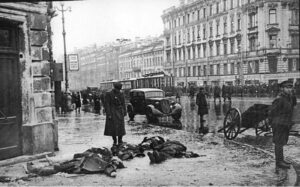 In reality, they gave science a bad name. The calculations made by German scientists before the invasion of Leningrad was launched in September of 1941, estimated that as many as 30 million Russian civilians would succumb to starvation. Hitler’s plan was to annihilate the Russian population and establish new German colonies in Eastern Europe. Hitler had a very specific idea of “the perfect race” and he would stop at nothing to achieve his goal.
In reality, they gave science a bad name. The calculations made by German scientists before the invasion of Leningrad was launched in September of 1941, estimated that as many as 30 million Russian civilians would succumb to starvation. Hitler’s plan was to annihilate the Russian population and establish new German colonies in Eastern Europe. Hitler had a very specific idea of “the perfect race” and he would stop at nothing to achieve his goal.
The people of Leningrad would experience Hitler’s cold German indifference to suffering firsthand. I suppose “German indifference” isn’t totally fair, because many of the German people were against the cruelty Hitler was so comfortable with. When the city was surrounded by September 1941, the Axis forces chose not to close in and engage in costly urban fighting, but to pound Leningrad from a safe distance and let hunger do the rest. They planned to block all transportation of vehicles in and out of the city, until all food ran out, and the people died from starvation.
Hitler’s plan left out one thing…a Surrender Option. The people could not surrender and live. They wanted then to die, and that was going to be their only option. Hitler’s direct order was to ignore the offer to surrender, saying “Requests for surrender resulting from the city’s encirclement will be denied, since the problem of relocating and feeding the population cannot and should not be solved by us.”
Hitler was ruthless. The city’s water and food supplies were cut off, and extreme famine soon set in. The siege of Leningrad began on September 8, 1941, and ended after a grueling two-year period on January 27, 1944. Yes, the siege produced starvation and disease, but Hitler took it a step further…to psychological torment. On Hitler’s orders, Leningrad suffered a daily barrage of artillery attacks from the German and Finnish forces that encircled it. The people were already starving, and lack of food or drink for long periods of time, can make something like an artillery attack, be that much more unsettling…even to the point of more than terror. They are dealing with gnawing hunger, and the terror of wondering if the artillery will hit them, and they should be, because Hitler would not care if he hit a civilian, accidently or on purpose. The people had no recourse, and no way out. After 872 days of starvation, disease, and the artillery attacks, the citizens of Leningrad…the ones who 
 were left anyway, were freed, but to what. Their city had been overtaken, many had family members who had died, their businesses were gone, their homes were gone…they had lost it all. In total, roughly 1.5 million people were killed during the siege of Leningrad while some 1.4 million were evacuated. I’m sure Hitler was still disappointed with the outcome, because he wanted them all dead.
were left anyway, were freed, but to what. Their city had been overtaken, many had family members who had died, their businesses were gone, their homes were gone…they had lost it all. In total, roughly 1.5 million people were killed during the siege of Leningrad while some 1.4 million were evacuated. I’m sure Hitler was still disappointed with the outcome, because he wanted them all dead.
 During World War II, many children lost their parents to hunger or bombings. Many of the orphanages were either overcrowded or non-existent. To save them from starvation, many Russian military units adopted the orphans. I’m not sure what the units did with the children while they were fighting, but my guess is that some of them wrote home to their wives and told them that they wanted to adopt these little cuties.
During World War II, many children lost their parents to hunger or bombings. Many of the orphanages were either overcrowded or non-existent. To save them from starvation, many Russian military units adopted the orphans. I’m not sure what the units did with the children while they were fighting, but my guess is that some of them wrote home to their wives and told them that they wanted to adopt these little cuties.
Two year old Lucy was adopted by Russian sailors of the Baltic Fleet after her parents died during the siege of Leningrad. Of course, she was too young to really remember her parents, and so whoever ended up adopting her would become her parents in her mind. Little is known about what happened to Lucy after this picture was taken, but if she is still alive, she would be in her mid-seventies now.
Of course, not all children were as blessed to find homes. One orphaned boy who had to live in a foster home wrote in a small notebook about how many of his friends were dying of hunger, and at the same time he drew “amazing” images of food such as “ham and chicken” in the pages of his diary. I guess he was trying to remind himself about the good old days…when food was abundant and his parents were still alive.
People who were living in Leningrad during the siege went through the worst of times. In all, the siege lasted 900 days (almost 2½ years). Food was scarce, and the people withered away. They could not escape and they could not bring in supplies. Eventually, people began to die. In all, more than a million civilians died during those horrible days. Lucy’s parents were among those who didn’t make it, probably because they gave what 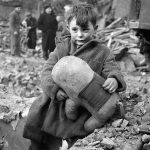 little food they had to her. I can’t imagine what must have gone through their minds. They must have agonized over the instinct to do whatever it took to keep their child alive, and wondering what would happen to her if they died and left her orphaned.
little food they had to her. I can’t imagine what must have gone through their minds. They must have agonized over the instinct to do whatever it took to keep their child alive, and wondering what would happen to her if they died and left her orphaned.
I wish there was a way to find out what happened to Lucy. I hope she had a good life with loving parents, who gave her the kind of life her own parents would have given her, had they lived. I hope she grew up to have a husband and children of her own. And I hope that her adoptive parents told her about the parents who loved her so much that they allowed themselves to starve to death, that she might live. Such a sacrifice should not go unnoticed, nor should it ever be forgotten.
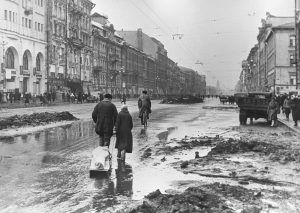 When an evil empire, such as Hitler’s regime in Nazi Germany, decides to rule the world, they begin to take over neighboring nations…by any means possible. If the nation is too weak to fight, it is easy, but if the nation can fight it becomes much harder to succeed. Nevertheless, they always seem to find a way, if they are determined enough. And Hitler was nothing, if not determined. The Nazis invaded the Soviet Union in late September, and surrounded Leningrad soon after. The months that followed, found the people of the city trying to establish supply lines from the Soviet interior and attempting to evacuate its citizens. It was a tough process and they often found themselves using a hazardous “ice and water road” across Lake Ladoga. A successful land corridor was finally created in January 1943, and the Red Army finally managed to drive off the Germans the following year. Nevertheless, all that took time, and in the end, the siege lasted nearly 900 days and resulted in the deaths of more than 1 million Soviet civilians.
When an evil empire, such as Hitler’s regime in Nazi Germany, decides to rule the world, they begin to take over neighboring nations…by any means possible. If the nation is too weak to fight, it is easy, but if the nation can fight it becomes much harder to succeed. Nevertheless, they always seem to find a way, if they are determined enough. And Hitler was nothing, if not determined. The Nazis invaded the Soviet Union in late September, and surrounded Leningrad soon after. The months that followed, found the people of the city trying to establish supply lines from the Soviet interior and attempting to evacuate its citizens. It was a tough process and they often found themselves using a hazardous “ice and water road” across Lake Ladoga. A successful land corridor was finally created in January 1943, and the Red Army finally managed to drive off the Germans the following year. Nevertheless, all that took time, and in the end, the siege lasted nearly 900 days and resulted in the deaths of more than 1 million Soviet civilians.
The German and Finnish forces besieged Lenin’s namesake city after their spectacular initial advance during Operation Barbarossa in the summer of 1941. Nevertheless, it was not going to be an easy task to bring the Soviet people into submission. A German Army Group struggled against stubborn Soviet resistance to isolate and seize the city before the onset of winter. The fighting was heaviest during August. German forces reached the city’s suburbs and the shores of Lake Ladoga, severing Soviet ground communications with the city. In 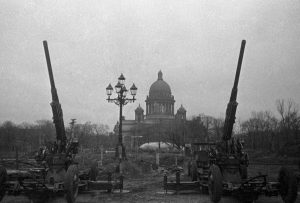 November 1941, Soviet forces repelled a renewed German offensive and clung to tenuous resupply routes across the frozen waters of Lake Ladoga. After that, German and Soviet strategic attention shifted to other more critical sectors of the Eastern Front, and Leningrad…its defending forces and its large civilian population…endured an 880 day siege of unparalleled severity and hardship. I simply can’t imagine the cruelty of a regime that would let a million people starve to death to obtain power. Despite desperate Soviet use of an “ice and water road” across Lake Ladoga to resupply its three million encircled soldiers and civilians and to evacuate one million civilians, over one million civilians perished during that bitter siege. Another 300,000 Soviet soldiers died defending the city or attempting to end the siege. In January 1943, Soviet forces opened a narrow land corridor into the city through which vital rations and supplies again flowed. But it was not until January 1944, that the Red Army successes in other front sectors enable the Soviets to end the siege. By this time, the besieging German forces were so weak that renewed Soviet attacks drove them away from the city and from Soviet soil. Determination simply wasn’t enough to win that victory for Hitler.
November 1941, Soviet forces repelled a renewed German offensive and clung to tenuous resupply routes across the frozen waters of Lake Ladoga. After that, German and Soviet strategic attention shifted to other more critical sectors of the Eastern Front, and Leningrad…its defending forces and its large civilian population…endured an 880 day siege of unparalleled severity and hardship. I simply can’t imagine the cruelty of a regime that would let a million people starve to death to obtain power. Despite desperate Soviet use of an “ice and water road” across Lake Ladoga to resupply its three million encircled soldiers and civilians and to evacuate one million civilians, over one million civilians perished during that bitter siege. Another 300,000 Soviet soldiers died defending the city or attempting to end the siege. In January 1943, Soviet forces opened a narrow land corridor into the city through which vital rations and supplies again flowed. But it was not until January 1944, that the Red Army successes in other front sectors enable the Soviets to end the siege. By this time, the besieging German forces were so weak that renewed Soviet attacks drove them away from the city and from Soviet soil. Determination simply wasn’t enough to win that victory for Hitler.
After November 1941, possession of Leningrad held only symbolic significance. In holding the “ice and water road” the Soviets were able to bring in enough supplies to stave of the ongoing starvation, so the siege has a 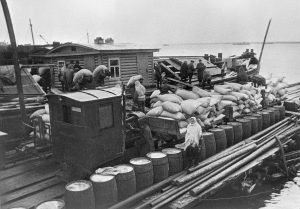 little less effect. The Germans maintained their siege with a single army, and defending Soviet forces numbered less than 15 percent of their total strength on the German-Soviet front. The Leningrad sector was clearly of secondary importance, and the Soviets raised the siege only after the fate of German arms had been decided in more critical front sectors. Despite its diminished strategic significance, the suffering and sacrifices of Leningrad’s dwindling population and defending forces inspired the Soviet war effort as a whole. No nation can lose that many people and not feel its impact. The siege ended on January 27, 1944, but I don’t think the people felt that it was such a big victory, considering the loss of life.
little less effect. The Germans maintained their siege with a single army, and defending Soviet forces numbered less than 15 percent of their total strength on the German-Soviet front. The Leningrad sector was clearly of secondary importance, and the Soviets raised the siege only after the fate of German arms had been decided in more critical front sectors. Despite its diminished strategic significance, the suffering and sacrifices of Leningrad’s dwindling population and defending forces inspired the Soviet war effort as a whole. No nation can lose that many people and not feel its impact. The siege ended on January 27, 1944, but I don’t think the people felt that it was such a big victory, considering the loss of life.

